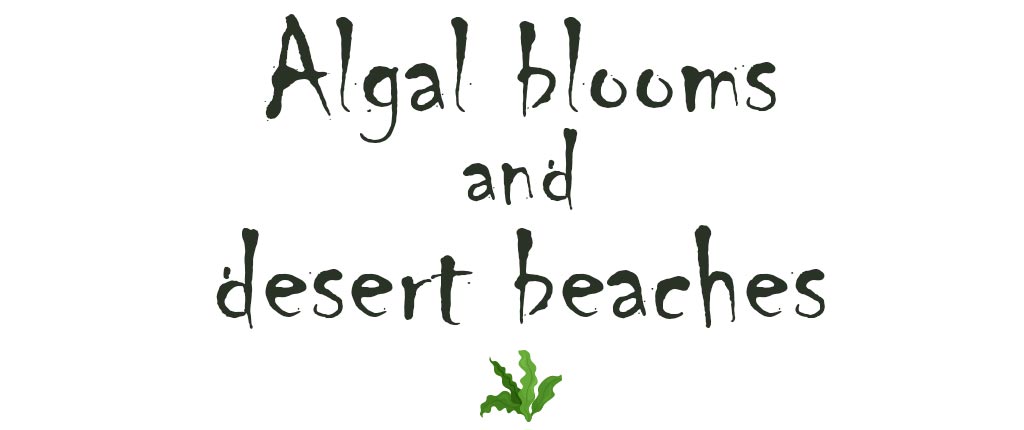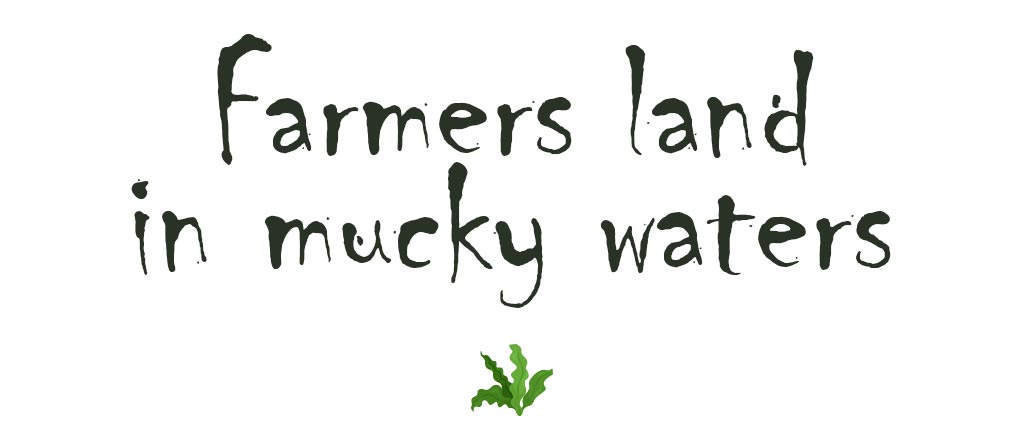A favourite of summer holidaymakers, the bay of Saint-Brieuc in northwest France has been swamped by tonnes of toxic green algae, dealing a blow to a region that hoped to have put the noxious – and potentially lethal – scourge behind it.


At first glance, Jean-Paul Bertaud’s seaside retreat is a little corner of paradise: a wooden cabin on stilts, perched above a sandy beach in the picturesque bay of Saint-Brieuc, on Brittany’s rugged northern coast.
And yet, before visitors even reach for the window to soak up the view, a foul stench of rotten eggs reveals a noxious presence and a sinister threat. This should be one of France’s finest beaches, but the sand is covered with stinking piles of decomposing algae that have swamped the shore.
“I’ve been coming here for 30 years so I’m used to the green algae, but now we can see they’re getting closer,” says Bertaud, a pensioner who hails from the Paris suburb of Choisy-le-Roi.
“The sand has been taken over, the algae are rotting on the spot and this creates little bogs that can be very dangerous,” he adds, pointing at darker patches of sludge among the heaps of seaweed washed up on Valais Beach, on Brittany’s Côtes d’Armor coast.

The threat of toxic fumes given off by the sludge has led the mayor of Saint-Brieuc to close the beach to the public. The owners of the other cabins that dot the beach are barred from entering their homes, some of which are literally perched above the slime.
The handful of tourists who venture this far soon turn back upon reaching a barrier with a sign that reads, “Danger Toxic Gas”, in French and English, complete with skull and crossbones. Just like the visitors, local resident Sylviane Morin, whose bungalow lies at the other end of the beach, can go no further – much to her despair.

“My family has been coming here for 70 years, and this is the first time we’re barred from our cabin!” Morin laments. “I’m used to having my sister, nephews and cousins stay over, but this summer it won’t be possible. We’ll have to wait for the big winter tides, for the storms and wind, to get rid of all this.”
Contacted by France 24, Saint-Brieuc town hall said the piles of sludge on the beach had rendered the soil unstable, making it impossible for municipal workers to clear up the seaweed. It blamed this year’s “exceptional” weather for the scourge.
“The influx of green algae began very early, there were few storms and June was a relatively wet month, which caused more water to flow from agricultural areas and thus more green algae,” said the town hall’s press officer.

The town hall’s readiness to close the beach and ward off visitors signals a broader change of attitude regarding the algae crisis, with local officials no longer willing to minimise the risks.
The massive influx of algae – also known as sea lettuce – was first reported in the early 1970s. Scientists have linked its proliferation to the development of agro-industry in the region, particularly pig, cattle and poultry farming, which is a cornerstone of the Breton economy. Nitrates and phosphates from fertilisers and animal waste pollute the water system and end up in the sea, where they feed the algae and cause algal blooms – or “green tides”.
It took years of campaigning for the authorities to finally recognise the seaweed’s toxicity, a struggle recounted by journalist Inès Léraud in her recently published comic book, “Algues vertes, l’histoire interdite” (Green algae, the forbidden history).
In the meantime, at least three people and dozens of animals (including wild boars, dogs and a horse) have died after inhaling hydrogen sulfide (H2S), a potentially lethal gas released by decaying algae.


Over in Hillion, on the other side of the bay, André Ollivro is out examining a crust of rotting algae, which cracks under his weight. The dried upper layer of seaweed has taken on a similar hue to the sand, its shape evoking a large grass snake washed ashore. In the distance, one can just make out the deserted cabins of Valais Beach.
To reach the sludge, Ollivro stepped over several barriers reading, “No entry – algae washed ashore”. It takes a lot more to stop the 74-year-old founder of activist group Halte aux marées vertes (Stop the Green Tides). Ollivro has spent the past two decades battling to raise awareness of the danger of toxic algae. His perseverance has drawn the wrath of the region’s agro-industry, along with attempts at intimidation and even death threats.

Using a trowel, Ollivro delicately lifts the crust of dried algae to access the pockets of hydrogen sulfide trapped underneath. A measuring device regularly emits a “beep”, a sign that we should step away. The measure is “only” 18 parts per million (ppm), a level at which the gas causes eye irritation and releases its characteristic fetid odour of rotten eggs.
At 100 ppm, hydrogen sulfide impairs the olfactory nerve in two to five minutes, after which its smell is no longer perceptible. Exposure to concentrations of between 500 and 700 ppm leads to loss of consciousness, respiratory arrest, and eventually death if the person is not rapidly moved to fresher air. At 1,000 ppm or more, adult humans can die within minutes.
“These areas are like a mille-feuille that decomposes and turns into a minefield. Take one step, nothing happens. Take another, and you end up with 1,000 ppm,” says the veteran activist, who always has a gas mask at hand in the event of an emergency.

Ollivro says the current resurgence of green algae reflects the failure of successive government plans to regulate and drastically reduce the amount of nitrates released by farms.
“How do you expect this to work when the number of pigs in Brittany keeps rising?” he asks. “Look, now local officials are panicking! They were told that everything would get better – and now what will they say to the tourists?”
Now that the toxicity of green algae has been established, members of “Stop the Green Tides” are looking beyond H2S detectors. Their next objective is to acquire a “nitrometre” in order to measure the level of nitrates present in the region’s waterways. Reducing that level is a key aim of a state-funded four-year plan to stem the proliferation of green algae by 2021, and the data for nitrates and other pollutants is set to be a key battleground for environmental activists and representatives of the agro-industry.
“Since the latest green tides, people in the farming lobby have kept their heads buried in the sand,” says Ollivro. “We’re going to keep campaigning for a real change in our agriculture. The farmers who are prisoners of this intensive model, who have invested a lot, must be compensated for things to really change.”


The farmers who agree to talk to the press generally share one grievance: they’re fed up with being “scapegoated” for a situation they say has multiple causes. Many in the agriculture industry feel the blame for the proliferation of green algae is unfairly pinned on them. They point the finger at seaside communities whose used waters are released into the sea.
“Farmers were certainly partly at fault, but a lot has been done [to address the algae problem], and no-one ever mentions this,” says Hervé, the owner of a pig farm in Lantic, who declined to give his full name.
His estate, which produces some 5,000 hogs on average each year, lies a few kilometres from the sea – and a stone’s throw away from the region’s algae processing plant, placing it on the front line of the battle against the toxic seaweed.

“We see the trucks drive past, loaded with green algae,” says the farmer. “When they’re fresh it’s not so bad, they bring a scent of seawater. But it’s true there was a very unpleasant smell about a month ago.”
According to French weekly Le Journal du dimanche, the Lantic plant was swamped with some 8,000 tonnes of green algae in just a few weeks, the total amount for the whole of 2018. Overwhelmed by this “tsunami” of algae, as the director called it, the plant temporarily closed its gates on July 3 amid mounting complaints from local residents sickened by the fetid odours emanating from the rotting sludge.
“It was indeed pretty awful at times, but I’m hardly in a position to complain,” Hervé says with a grin, pointing at a huge manure tank with a capacity of 1,100 cubic metres. The waste produced by his pig herd and stored in the tank will provide two-thirds of the fertiliser needed for his crops, which in turn will feed his hogs. As the farmer puts it, the manure “is gold for us”.
In order to curb pollution of the water system, Hervé stores the manure in several large tanks and spreads it on the crops only during periods of growth, when the consumption of nitrates is highest. Other measures include planting “cover crops”, using plants such as phacelia that absorb the nitrates. And to stop the nitrates from flowing into the water system, farmers must now leave six-metre-wide buffer zones between their crops and streams or rivers.

Official statistics suggest farmers’ efforts to limit pollution have helped lower the level of nitrates seeping into the region’s waterways. But the improvement is yet to translate into a lasting decrease in the green tide phenomenon.
For the likes of Hervé, going back to a less intensive agricultural model is simply not a realistic option.
“I’ll tell you how our elders coped,” he says. “It’s simple: they starved to death! They ate meat once a week, on Sundays. People have forgotten this nowadays, because their plates are always full.”
Dishes are indeed full along the bay of Saint-Brieuc, a few kilometres down the road, but the decision to cordon off whole sections of the shore has angered many local residents, who have had enough of the algae curse.
Close to the beach in Hillion, a rusting snow plough sits idle a few steps away from piles of green algae. It’s a bizarre sight, to say the least. But in the bay of Saint-Brieuc, the locals are no longer surprised to see such engines brought in from the Alps, at the other end of the country, to help dig up the seaweed. The extraordinary is the new normal.

